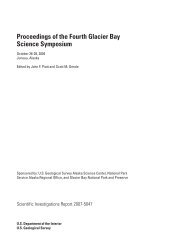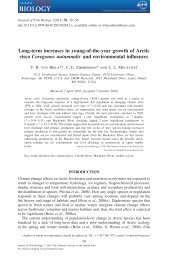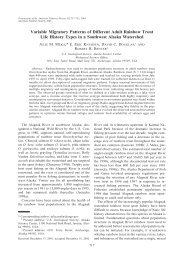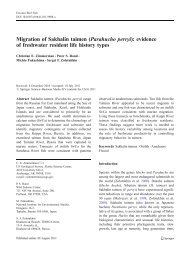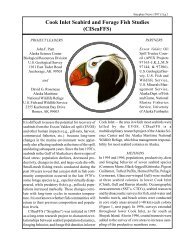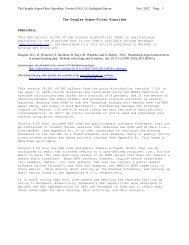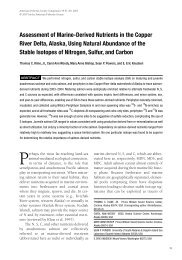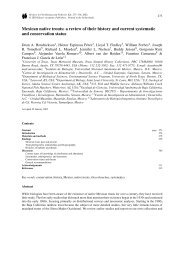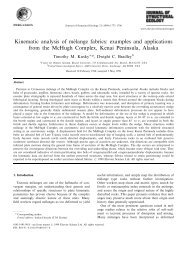UNCORRECTED PAGE PROOFS - USGS Alaska Science Center
UNCORRECTED PAGE PROOFS - USGS Alaska Science Center
UNCORRECTED PAGE PROOFS - USGS Alaska Science Center
You also want an ePaper? Increase the reach of your titles
YUMPU automatically turns print PDFs into web optimized ePapers that Google loves.
spe371-01 page 15 of 31<br />
Geologic signature of early Tertiary ridge subduction in <strong>Alaska</strong> 15<br />
belt. Paleoßow was along the trench axis, mainly toward the<br />
western end of the belt (Moore, 1973; Nilsen and Moore, 1979)<br />
(Fig. 11).<br />
Sedimentary rocks that are interbedded with volcanic<br />
rocks in the Orca Group, the Knight Island and Resurrection<br />
Peninsula ophiolites, and the Ghost Rocks Formation correspond<br />
to stage 2. Paleocurrent data from the Ghost Rocks<br />
Formation indicate turbidity ßows toward virtually every point<br />
of the compass, in contrast with strong axial paleocurrents of<br />
the slightly older Kodiak Formation (Nilsen and Moore, 1979).<br />
Some paleocurrent data are also available for the Orca Group<br />
(Winkler, 1976), which show ßow directions toward the north,<br />
west, and south, but not toward the east.<br />
Accreted sedimentary rocks related to stage 3 lie immediately<br />
outboard of the Sanak-Baranof near-trench intrusives,<br />
the ophiolites, and the volcanic rocks. They are interpreted as<br />
closely post-dating the near-trench magmatism episode. On<br />
Kodiak Island and adjacent islands, Eocene deep-sea turbidites<br />
of this outboard belt have been named the Sitkalidak Formation.<br />
Paleocurrent directions reported by Nilsen and Moore<br />
(1979) are predominantly toward the southeast (i.e., seaward,<br />
perpendicular to the margin).<br />
Sandstone compositions show progressive changes through<br />
the time interval of interest, as well as some anomalies corresponding<br />
to stage 2 (Fig. 12). In Prince William Sound (Dumoulin,<br />
1987, 1988) sandstones of Stage 1 (Valdez Group and<br />
inboard part of the Orca Group) contain abundant volcanic lithic<br />
clasts, locally abundant grains of pyroxene and amphibole, and<br />
little quartz. They were derived from a progressively unrooÞng<br />
magmatic arc with increasing input from subduction-complex<br />
sources through time. Similar compositions have been reported<br />
for the Kodiak Formation to the west, and the Sitka Graywacke<br />
to the east (e.g., Zuffa et al., 1980). Stage 2 sandstones interbedded<br />
with volcanic rocks (locations 6, 7, and 8, Fig. 3) are richer<br />
in feldspar and quartz and generally Þner grained and better<br />
sorted than sandstones in adjacent areas. These differences<br />
could be due to barrier effects of local topography. Stage 3 sandstones<br />
of the Orca Group on Montague Island (Fig. 3) and the<br />
Ragged Mountain area (location 13, Fig. 3) are relatively rich in<br />
quartz and sedimentary lithic clasts and correlate well with the<br />
Sitkalidak Formation on Kodiak Island to the west (Nilsen and<br />
Moore, 1979; Moore et al., 1983). Provenance of these younger<br />
rocks reßects increased contributions from subduction complex<br />
sources and waning input from a magmatic arc.<br />
GOLD VEINS AND HYDROTHERMAL FLUID-FLOW<br />
IN THE ACCRETIONARY PRISM<br />
The Chugach–Prince William terrane is host to dozens<br />
of small turbidite-hosted lode-gold deposits. Similarities in<br />
structural setting, vein mineralogy, alteration assemblages,<br />
stable isotope geochemistry, and ßuid inclusion P-T-X data for<br />
a distance of >1000 km along the continental margin suggest a<br />
common origin for these deposits (Goldfarb et al., 1986, 1997).<br />
In south-central <strong>Alaska</strong>, most of the deposits are hosted by rocks<br />
of the Valdez Group or the landward part of the Orca Group. In<br />
southeastern <strong>Alaska</strong>, the gold deposits are hosted by the Sitka<br />
Graywacke, and by older metamorphic and igneous rocks of the<br />
Wrangellia composite terrane within about 5–10 km of the Border<br />
Ranges fault system. Many occupy faults, as discussed under<br />
the next heading. 40 Ar/ 39 Ar ages on micas from ten of the gold<br />
veins fall along the same age trend as the Sanak-Baranof plutons<br />
(Haeussler et al., 1995) (Fig. 4A), requiring a common tectonic<br />
setting for magmatism and the regional hydrothermal event.<br />
The gold-bearing veins throughout the <strong>Alaska</strong>n margin<br />
are typically discordant, steeply dipping, high-grade (many<br />
30 g/t Au), and relatively small. The quartz veins contain gold,<br />
arsenopyrite, pyrite, and hydrothermal muscovite/sericite. The<br />
small size of vein systems suggests that, on the scale of the<br />
accretionary prism as a whole, ßuid ßow was relatively diffuse.<br />
The most important producers in south-central <strong>Alaska</strong> were the<br />
Cliff mine (location 18, Fig. 3), which yielded about 1.5 tonnes<br />
Au from ore averaging 53 g/t, and the Granite mine (location<br />
19, Fig. 3), which yielded about 0.75 tonnes Au. None of the<br />
other small mines in south-central <strong>Alaska</strong> yielded more than<br />
200,000 g Au. In contrast, the Chichagof/Hirst-Chichagof vein<br />
systems in southeastern <strong>Alaska</strong> contain about 30 tonnes Au<br />
(production plus reserves) from ore averaging slightly more<br />
than 30 g/t Au. These larger, more productive veins indicate a<br />
more voluminous concentration of hydrothermal ßuid. Goldfarb<br />
et al. (1997) suggested that the onset of transcurrent motion<br />
along the southern part of the Border Ranges fault system may<br />
have favored establishment of a large second-order fault system<br />
that was capable of the more extensive ßuid focussing.<br />
The gold deposits are regionally restricted to areas of greenschist<br />
facies metamorphic rocks and are only rarely present in<br />
lower- or higher-grade metamorphic rocks (Goldfarb et al.,<br />
1986, 1997). δ 18 O values for quartz from more than 30 deposits<br />
range between 13 and 17.5‰; ßuid-inclusion microthermometry<br />
suggests that veins were deposited from low-salinity aqueousdominant<br />
ßuids containing about 5–10 mol% gas at 210–360 °C<br />
and 100–300 MPa (1–3 kbar). Quantitative mass spectrometry<br />
indicates that the non-aqueous volatiles in the ßuids include<br />
CO 2<br />
, CH 4<br />
, N 2<br />
, and H 2<br />
S. These data are together interpreted to<br />
indicate that vein-forming ßuids were produced from devolatilization<br />
reactions within the previously accreted ßysch. Whereas<br />
quartz veins (and thus ßuid ßow) are present throughout the<br />
Chugach–Prince William terrane, the restriction of most gold<br />
and arsenopyrite to veins in greenschist regions is consistent<br />
with desulÞdization reactions predominating in these moderate<br />
P-T regions (e.g., Ferry, 1981). The H 2<br />
S made available to<br />
crustal ßuids during conversion of sedimentary pyrite to pyrrhotite<br />
is critical for complexing gold and arsenic in hydrothermal<br />
solutions. The H 2<br />
S is additionally likely to complex mercury,<br />
and transport it into relatively low-T crustal regimes. Cinnabar,<br />
which has been found in pan concentrates in many drainages<br />
in the Seldovia quadrangle (Fig. 2), probably was derived from<br />
some of the most shallowly emplaced vein systems.<br />
<strong>UNCORRECTED</strong> <strong>PAGE</strong> <strong>PROOFS</strong>




